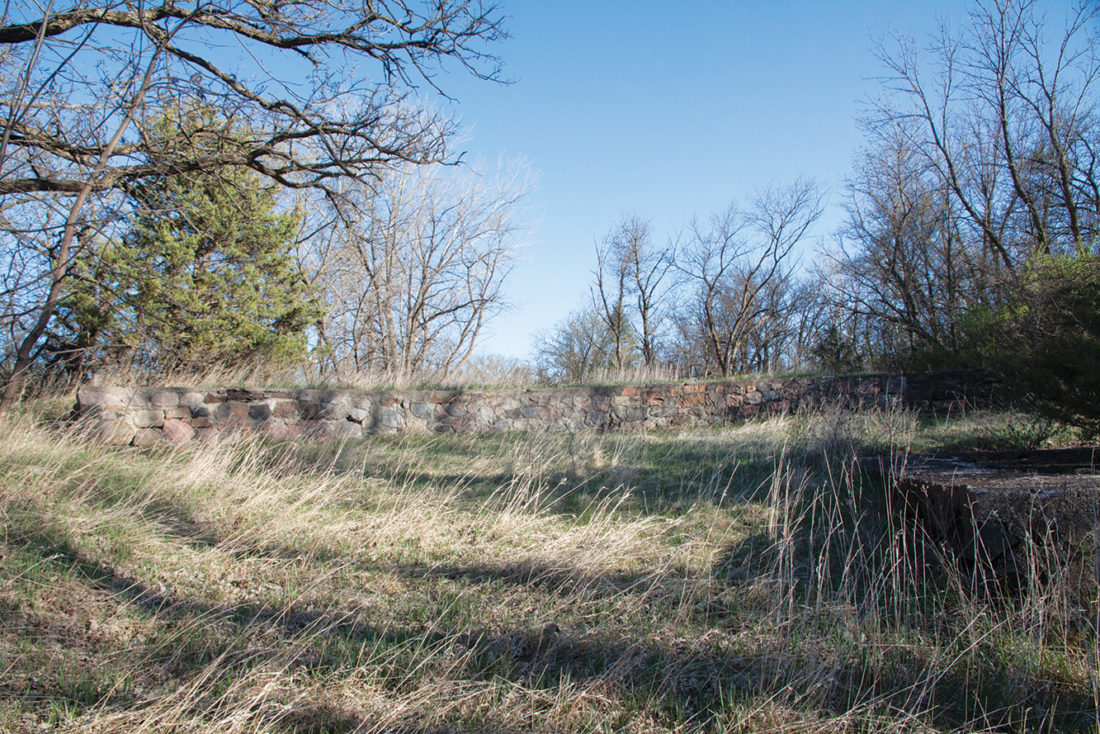Project to preserve historic Granite Falls river park

Photo courtesy of Kristi Fernholz, UMVRDC The Granite Falls Memorial Park amphitheater built in 1936 and featured a slab at the center of its base which was originally meant to include a cannon.
GRANITE FALLS — One of the Minnesota River’s best recreational parks has a future in the 21st century thanks to ongoing modernization efforts.
The city of Granite Falls and the Appleton-based Upper Minnesota Valley Regional Development Commission are four years into the process of bringing a comprehensive master plan for Memorial Park closer to reality.
Their grant-supported projects have already led to improvements to the park’s picnic shelter constructed from granite in 1937. Further upgrades are planned for both the shelter and components of the campground area, which is located on the opposite side of Minnesota Highway 67.
“We’ve made a start,” said UMVRDC Senior Planner Kristi Fernholz. “We’ve set priorities and we’ll meet them based on what’s most important and on the availability of funds.”
The picnic shelter ranked high on the list because of its riverside location and its continued potential as a scenic gathering place for a variety of events. It measures 3,200 square feet, making it larger than most houses. It also has a fireplace that has received structural repair to prevent it from having foundation issues.
The 141-acre Memorial Park was created in 1925 when land was purchased by the American Legion after a water carnival fundraiser. The park was established with the idea of making it a tribute to veterans who served in World War I, originally known as the Great War.
Many of its historical features were created through the Works Progress Administration’s job corps efforts in the 1930s. An amphitheater built in 1936 featured a slab at the center of its base which was originally meant to include a cannon.
The park’s blue bathhouse was built in 1938. It had a capacity for 200 people at a time when the park had a long beachfront next to the Minnesota River that was popular for swimming.
Almost a century later, the amphitheater became overgrown with vegetation. The bathhouse was abandoned after the beach disappeared because of changes to the river channel and the facility itself was flooded out several times in the 1997 flood disaster and other periods of high water depths.
Repair of the bathhouse was ruled out because of the need to totally rebuild the roof and interior fixtures. Repurposing (through a different use of the site) was not feasible because of close proximity to Highway 67.
Information contained in 2015 master plan for improvements notes that choices are influenced by how the long term flow of the river has not been established following the removal of the Minnesota Falls Dam. The dam was located a short distance downstream from Memorial Park near an historically popular fishing spot known as Pete’s Point.
Until the configuration becomes better established, it will not be practical to invest in a fishing pier or new landings for boats and canoes.
Fernholz said other natural factors have already begun to work in Memorial Park’s favor. Funding prospects are enhanced by location, since no other city on the upper Minnesota River has a river park that is nearly as large.
Park needs also correspond to several statewide goals for natural and historic preservation. Rock outcroppings offer views of granite rock that is among the oldest geological formations in Minnesota. The prevalence of buckthorn, poison ivy and wetland cattails call for invasive species control methods advocated by state environmental agencies.
Memorial Park is also a site for the morel mushroom, which is Minnesota’s official state mushroom and a symbol of well-preserved natural locations.
Last but not least, it provides a river area habitat for the Five Lined Spink. It is classified as one of Minnesota’s rare species.
Fernholz said long range possibilities include more access to the park’s largest wetland and decisions about how to guarantee safe highway crossings. In the past a tunnel under Highway 67 was a widely used option other than crossing the road.
“We’ll do as much as much as we can within each available budget,” she said. “At this point we’ve focused on the greatest needs. Other ideas are eventual long term goals.”
She said park improvement planning has corresponded to promotional efforts organized by the city and UMVRDC. An important tourism awareness step was the designation as a regional park, which leads to more tourism advertising opportunities.
UMVRDC has also been an advocate for the scenic byway designation that was given to a large area of the Minnesota River valley. It has helped with promotions such as the region’s annual Meander self-guided art studio tours.
Meanwhile Memorial Park has hosted recent events such as river tours for Bert Raney Elementary School classes conducted by the Prairie Woods Environmental Learning Center of Spicer and sleigh rides during holiday seasons and Ole and Lena Days winter carnival weekends.
Granite Falls Economic Development Authority Director Cathy Anderson said city officials are encouraged by progress in Memorial Park made in the past several years. They look forward to other positive changes yet to come.
“Memorial Park has a long history of being an important recreational asset to Granite Falls,” Anderson said. “We’re planning for the future in ways that will sustain its value.”



